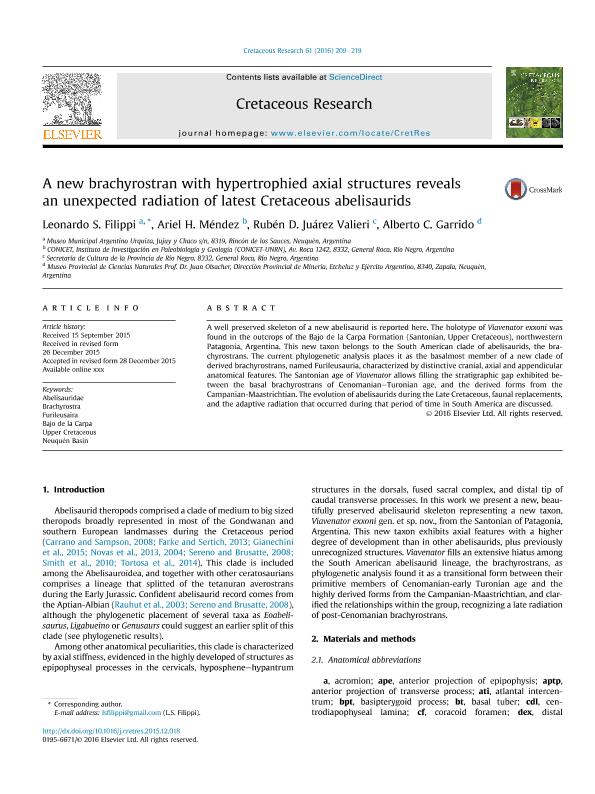Artículo
A new brachyrostran with hypertrophied axial structures reveals an unexpected radiation of latest Cretaceous abelisaurids
Fecha de publicación:
06/2016
Editorial:
Academic Press Ltd - Elsevier Science Ltd
Revista:
Cretaceous Research
ISSN:
0195-6671
Idioma:
Inglés
Tipo de recurso:
Artículo publicado
Clasificación temática:
Resumen
A well preserved skeleton of a new abelisaurid is reported here. The holotype of Viavenator exxoni was found in the outcrops of the Bajo de la Carpa Formation (Santonian, Upper Cretaceous), northwestern Patagonia, Argentina. This new taxon belongs to the South American clade of abelisaurids, the brachyrostrans. The current phylogenetic analysis places it as the basalmost member of a new clade of derived brachyrostrans, named Furileusauria, characterized by distinctive cranial, axial and appendicular anatomical features. The Santonian age of Viavenator allows filling the stratigraphic gap exhibited between the basal brachyrostrans of Cenomanian-Turonian age, and the derived forms from the Campanian-Maastrichtian. The evolution of abelisaurids during the Late Cretaceous, faunal replacements, and the adaptive radiation that occurred during that period of time in South America are discussed.
Archivos asociados
Licencia
Identificadores
Colecciones
Articulos(CCT - PATAGONIA NORTE)
Articulos de CTRO.CIENTIFICO TECNOL.CONICET - PATAGONIA NORTE
Articulos de CTRO.CIENTIFICO TECNOL.CONICET - PATAGONIA NORTE
Articulos(IIPG)
Articulos de INSTITUTO DE INVESTIGACION EN PALEOBIOLOGIA Y GEOLOGIA
Articulos de INSTITUTO DE INVESTIGACION EN PALEOBIOLOGIA Y GEOLOGIA
Citación
Filippi, Leonardo Sebastián; Méndez, Ariel Hernán; Juárez Valieri, Rubén; Garrido, Alberto Carlos; A new brachyrostran with hypertrophied axial structures reveals an unexpected radiation of latest Cretaceous abelisaurids; Academic Press Ltd - Elsevier Science Ltd; Cretaceous Research; 61; 6-2016; 209-219
Compartir
Altmétricas




